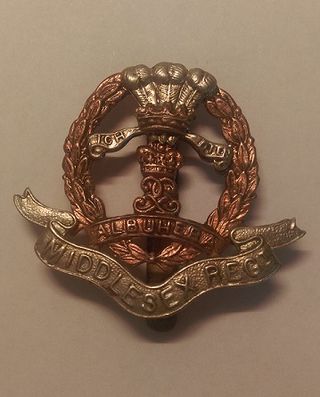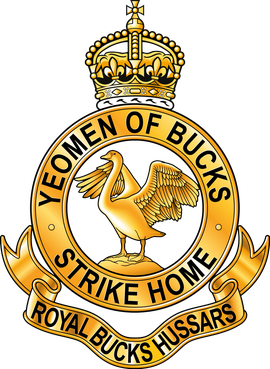
The Somerset Light Infantry (Prince Albert's) was a light infantry regiment of the British Army, which served under various titles from 1685 to 1959. In 1959, the regiment was amalgamated with the Duke of Cornwall's Light Infantry to form the Somerset and Cornwall Light Infantry which was again amalgamated, in 1968, with the King's Own Yorkshire Light Infantry, the King's Shropshire Light Infantry and the Durham Light Infantry to form The Light Infantry. In 2007, however, The Light Infantry was amalgamated further with the Devonshire and Dorset Regiment, the Royal Gloucestershire, Berkshire and Wiltshire Regiment and the Royal Green Jackets to form The Rifles.

The Oxfordshire and Buckinghamshire Light Infantry was a light infantry regiment of the British Army that existed from 1881 until 1958, serving in the Second Boer War, World War I and World War II.

The King's Own Yorkshire Light Infantry (KOYLI) was a light infantry regiment of the British Army. It officially existed from 1881 to 1968, but its predecessors go back to 1755. In 1968, the regiment was amalgamated with the Somerset and Cornwall Light Infantry, the King's Shropshire Light Infantry and the Durham Light Infantry to form The Light Infantry, which in turn was merged with the Devonshire and Dorset Regiment, the Royal Gloucestershire, Berkshire and Wiltshire Regiment and the Royal Green Jackets to become The Rifles in 2007.
The Childers Reforms of 1881 reorganised the infantry regiments of the British Army. The reforms were done by Secretary of State for War Hugh Childers during 1881, and were a continuation of the earlier Cardwell Reforms.

The 145th Infantry Brigade was a regional brigade of the British Army that saw active service in both the First and the Second World Wars, disbanding in 1943 and being reformed in the 1990s. The Brigade was renamed Headquarters 11th Infantry Brigade and Headquarters South East in October 2014.

The Middlesex Regiment (Duke of Cambridge's Own) was a line infantry regiment of the British Army in existence from 1881 until 1966. The regiment was formed, as the Duke of Cambridge's Own (Middlesex Regiment), in 1881 as part of the Childers Reforms when the 57th (West Middlesex) and 77th (East Middlesex) Regiments of Foot were amalgamated with the county's militia and rifle volunteer units.

The Border Regiment was a line infantry regiment of the British Army, which was formed in 1881 under the Childers Reforms by the amalgamation of the 34th (Cumberland) Regiment of Foot and the 55th (Westmorland) Regiment of Foot.

The Special Reserve was established on 1 April 1908 with the function of maintaining a reservoir of manpower for the British Army and training replacement drafts in times of war. Its formation was part of the military reforms implemented by Richard Haldane, the Secretary of State for War, which also created the Territorial Force. Haldane originally intended that the Militia would provide the reserve, but opposition from its representatives forced him to abolish it and create the Special Reserve instead. Only 60 per cent of the Militia transferred into the new reserve, and it was consistently under strength, particularly in officers. Reservists enlisted for a six-year term of service, and had to undergo six months of basic training on recruitment and three to four weeks training annually.
The West Suffolk Militia was a militia regiment in the United Kingdom from 1759 to 1881, when it was amalgamated into The Suffolk Regiment.
The Royal Wiltshire Militia was a militia regiment in Great Britain and the later United Kingdom from 1758 to 1881, when it was amalgamated into The Duke of Edinburgh's.
The Oxfordshire Militia was a militia regiment in the United Kingdom from 1759 to 1881, when it was amalgamated into The Oxfordshire Light Infantry.
The West Kent Militia, later the 3rd Battalion, Queen's Own was an auxiliary regiment raised in Kent in South East England. From its formal creation in 1758 the regiment served in home and colonial defence in all of Britain's major wars until 1918, and supplied thousands of reinforcements to the Royal West Kents during World War I.

The Royal Buckinghamshire Yeomanry is an Operational Hygiene Squadron of the Royal Logistic Corps, originally formed as cavalry in 1794, and has also served in artillery and signals roles. The lineage is continued by 710 Operational Hygiene Squadron, Royal Logistic Corps.
The Militia and Volunteers of County Durham are those military units raised in the County independent of the regular Army. The "modern" militia dates from legislation enacted during the Seven Years' War. The volunteers had several forms and separate periods of existence until made a permanent body in 1859.
The Lancashire Militia was an auxiliary military force in Lancashire in North West England. From their formal organisation as Trained Bands in 1558 and their service in the Williamite War in Ireland and against the Jacobite Risings, the Militia regiments of Lancashire served during times of international tension and all of Britain's major wars. They provided internal security and home defence but sometimes operated further afield, including Ireland and the Mediterranean, relieving regular troops from routine garrison duties, and acting as a source of trained officers and men for the Regular Army. All the infantry battalions went on active service during the Second Boer War and all served as Special Reserve training units in World War I, with one battalion seeing considerable action on the Western Front. After 1921 the militia had only a shadowy existence until its final abolition in 1953.
The 3rd Royal Lancashire Militia (The Duke of Lancaster's Own) was an auxiliary regiment raised in the county of Lancashire in North West England during the French Revolutionary War. It later became part of the Loyal North Lancashire Regiment. Although primarily intended for home defence, its battalions served in Ireland, Gibraltar and Malta and saw active service during the Second Boer War. After conversion to the Special Reserve (SR) under the Haldane Reforms it supplied reinforcements to the fighting battalions during World War I. After a shadowy postwar existence the unit was finally disbanded in 1953.
The Queen's Edinburgh Light Infantry Militia was an auxiliary regiment raised in and around the city of Edinburgh in Scotland. It was formed in 1798 and reformed in 1802, but had links with earlier Fencible and Volunteer units from the area. It served in home defence during the Napoleonic Wars and the Crimean War. Later it became a battalion of the Royal Scots and saw active service in South Africa during the Second Boer War. It served as a Special Reserve training unit in World War I, but after 1921 the militia had only a shadowy existence until its final abolition in 1953.
The King's Own Light Infantry Militia, later the 3rd Battalion, North Staffordshire Regiment was an auxiliary regiment raised in Staffordshire in the West Midlands of England in 1853. Under the Cardwell and Childers Reforms it became part of the North Staffordshire Regiment and saw active service during the Second Boer War. During World War I it trained thousands of reinforcements for the battalions serving overseas. After a shadowy postwar existence it was formally disbanded in 1953.
The Middlesex Militia was an auxiliary military force in the county of Middlesex in South East England. From their formal organisation as Trained Bands, in 1572 and their service during the Armada Crisis and in the English Civil War, the Militia regiments of Middlesex served during times of international tension and all of Britain's major wars. By 1853 there were five regiments in the county. They provided internal security and home defence but sometimes operated further afield, including France and the Mediterranean, relieving regular troops from routine garrison duties, and acting as a source of trained officers and men for the Regular Army. Some of the infantry battalions went on active service during the Second Boer War and all served as Special Reserve training units in World War I. After 1921 the militia had only a shadowy existence until its final abolition in 1953.
The 5th Middlesex Militia or Royal Elthorne Light Infantry was an auxiliary regiment raised in Middlesex in the Home counties of England just before the Crimean War. It later became part of the Middlesex Regiment. Primarily intended for home defence, it served in England and Ireland during Britain's major wars, and saw active service during the Second Boer War. It was converted to the Special Reserve under the Haldane Reforms and supplied reinforcements to the Royal Fusiliers' fighting battalions during World War I. After a shadowy postwar existence the unit was finally disbanded in 1953.







